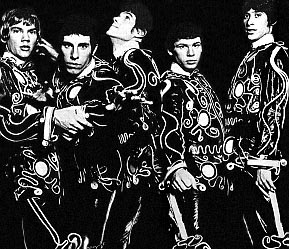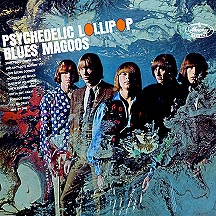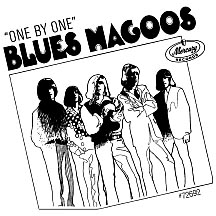BLUES MAGOOS
(We Ain't Got) Nothin' Yet
This group of guys got into the psychedelic mindset earlier than most, in 1965 or early '66. Even the original spelling of their name, The Bloos Magoos, had a hallucinogenic quality to it. Onstage performances included oversized lava lamps on either side of the stage; their album covers played up the splashy, colorful imagery of the era and their music often included purposely delusional lyrics and extemporaneous instrumental passages. The Magoos took it to the max!
That name, by the way, would suggest an affinity for the 1950s UPA cartoon character Mr. Magoo (so memorably voiced by Jim Backus), yet that is not the case, Keemosabe! The band's manager, Marvin Langenoff, got the idea while doin' a chopstick chow-down on some stir-fried moogoo gai pan at a Chinese restaurant one evening. "Moogoo"...he liked the sound of it. The band was predisposed to playing the blues, and with a couple of spelling twists the name came into being.
In actuality, the original name for the Bronx, New York group was The Trenchcoats, though they never recorded under it. High school buddies Ralph Scala ("quiet, shy, good looking, plays his organ while singing," as noted on the back cover of their still-to-come first album) and Ronnie Gilbert ("loud, funny, lazy, plays bass") started practicing together in 1964; guitarist Dennis LaPore and drummer John Finnegan joined in soon after. Upstart Emil Theilhelm ("lovable, drop-out, plays rhythm guitar"), later known as "Peppy" Castro, had a tougher time making the ranks because he was only 14, but his six-string dexterity soon became obvious and he had some good ideas for songs, too.
In 1965 the guys managed to get booked into a few grubby Bronx clubs paying them each about ten bucks a night. Performing went hand-in-hand with hunger for awhile and Scala has claimed he was so exhausted at one point that he slept through the power blackout of November 9, 1965...missed it completely. Once Langenoff got involved they were no longer desperate enough to have to go through the humiliation of returning to the Bronx for some of mom's home cooking; he set them up with producer Rick Shorter and soon they had completed their first and only single for the Verve Folkways label, "So I'm Wrong and You Are Right," sonically in sync with the folk-rock vibe of '65. Released in early 1966, it was universally overlooked.
The venues improved as they shifted over to Greenwich Village, appearing at the Cafe Wha? (a folk and rock showcase for Bob Dylan, The Velvet Underground and others, but also a hot spot for comedians, among them Lenny Bruce, Joan Rivers and Woody Allen) and the Night Owl Cafe (where The Lovin' Spoonful got their big break). Lapore and Finnegan departed and were replaced by Mike Esposito ("psyched-out, warm, friendly, rich, plays lead guitar") and Geoff Daking ("blond, beautiful, straight, plays drums").
A contract was signed with Mercury Records after which they fell under the supervision of all-genre record exec Shelby Singleton, who placed them with producers Bob Wyld and Art Polhemus. Singleton had faith in the group's collective songwriting abilites and put them to work on an entire album instead of just one or two singles, which was still the norm in '66. One noticeable change occurred around that time: "Bloos" was out, "The" was dropped, and the group's name became the more straightforward Blues Magoos. Based on the title of that first album, Psychedelic Lollipop, one might deduce that they were a bubblegum band. Not so, Sherlock! They were as much into blues and psychedelic experimentation as anyone could have been in the year of the garage band. Esposito's talents stretched beyond music to painting, and it was his canvas work that graced the album cover, superimposed with a photo of the band.
The first Mercury single was a wild interpretation of John D. Loudermilk's "Tobacco Road" (a hit the previous year for The Nashville Teens), a four-and-a-half minute single with a heavy blues bent and an instrumental jam midway through that went off the rails, an outrageous goulash of guitar and organ commencing around the three minute mark. It failed to gain much airplay in the radio world that would embrace longer rock tracks a year so later. The Magoos ventured past New York, playing live in most of the larger eastern cities. Detroit fans in particular embraced their brand of euphonious irrationality and a successful stint at Motor City hangout the Chess Mate Coffeehouse came just prior to that all-important follow-up single.

"(We Ain't Got) Nothin' Yet," conspicuously built upon the bass hook from Rick Nelson's rockin' 1962 version of "Summertime," started climbing the charts at the end of November '66 while the Lollipop album simultaneously began its ascent. More in line with garage rock than blues or psychedelia, the slightly ominous-sounding uptempo track evidently had the goods to become a smash; it went top ten at the end of January '67. Verve Folkways took a shot at riding the hit's coattails, rereleasing the band's year-old debut single (with the spelling of the name updated to Blues Magoos), again to no avail.
The next single, "Pipe Dream," was widely considered a drug song; this impression may have stemmed in part from the "Louie Louie"-esque tough-to-translate lyrics and closing line 'Come back to reality.' When Mercury's promotion staff had difficulty getting radio to play the song, a case was made for its flip side, "There's a Chance We Can Make It," which had been the group's first choice anyway. Both songs struggled on the low end of the charts in the spring of '67. The second album, Electric Comic Book, featuring both songs, sold fairly well but was overshadowed by the first LP, still riding the charts on the strength of "Nothin' Yet." They dipped back into that first album for the third single, "One By One," a more poppish song, reminiscing about 'childhood dreams' and 'any girl who lived next door.' A brief chart run in June turned out to be their last.
Electric Comic Book partially lived up to its title by including a comic book insert with ads designed to entice kids into forking over their allowance money, hawking iron-on transfers while one ad proclaimed "You no longer have to be a 98 lb. weakling - join the Blues Magoos Society!" The most prominent offer touted the "Psyche-De-Lite" lava lamp, a much smaller version of the luminous lamps the band used onstage. The sales pitch claimed "It undulates...it'll blow your mind! The glowing red LAVA lives...breathes...fascinates...you'll watch it for hours, absolutely hypnotized." There ya go: mind control on its most commercial level.
The guys also took to wearing garish "electric suits" (a designer's nightmare with lit-up squiggly lines), more a marketing idea (as were the comic book ads) of Wyld and Polhemus. The producing pair convinced them to do a Christmas single ("Jingle Bells" backed with "Santa Claus is Coming to Town") and by this time the yearlong merry-go-round of blatant promotional gimmickry had gotten to them; they made a clean break from Wyld and Polhemus and produced the third album themselves. Basic Blues Magoos toned down the over-the-top imagery while focusing more on the blues-rock formula, but the stars weren't aligned for this project to connect. Leaving Mercury for good, everyone except Peppy headed to the west coast to ply their trade between Los Angeles and San Francisco. One Blues Magoos single came out on the obscure Ganim label in 1968, a remake of Bo Diddley's "Who Do You Love." The owners of the soon-to-be nonexistent company gave them the boot when it didn't sell; Quicksilver Messenger Service had better luck with the song a year later, transforming it into a complete-side 25 minute album cut and 3:24 single edit that received a decent amount of summer '69 airplay.
Blues Magoos scattered after this latest fiasco. Scala and Esposito stayed on the music scene for awhile before taking regular jobs in the "real world." Wyld and Polhemus had calculatedly secured the rights to the group's name and reformed the band around "Peppy" Castro; three singles (including "Heartbreak Hotel," dripping of desperation beyond the intention of Elvis Presley's original) and two albums were released on ABC Records in '69 and '70. Afterwards, Castro moved on to other bands including Balance, a New York-based group that took the formulaic "Breaking Away" to the top 40 in 1981.



